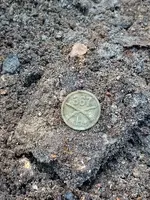UnderMiner
Silver Member
- Joined
- Jul 27, 2014
- Messages
- 3,932
- Reaction score
- 10,283
- Golden Thread
- 2
- Location
- New York City
- 🥇 Banner finds
- 2
- Detector(s) used
- Minelab Excalibur II, Equinox 800
- Primary Interest:
- All Treasure Hunting
Was bottle hunting today in my 1924-capped landfill when I found a 1917 French Croix de Guerre. It is 106 years old and has been buried for at least 99 of those years.
In situ:

It was in one of my spoil heaps and had been washed out by the recent rains.


This find substantiates the stories I use to hear of WWI soldiers who threw away their medals after returning home from the war. Those medals didn't disappear from this world simply because they entered those landfills though, as this award demonstrates.
The medal was awarded mostly to soldiers of foreign millitary forces allied to France.
Here is a soldier wearing the decoration:

Some more of the things I found today:


The white bowl is 19th century British imported Ironstone Anchor Pottery, it is intact apart from one of the handles being broken off, but easily repairable. Here is the bottom:

That's all for now.
In situ:
It was in one of my spoil heaps and had been washed out by the recent rains.
This find substantiates the stories I use to hear of WWI soldiers who threw away their medals after returning home from the war. Those medals didn't disappear from this world simply because they entered those landfills though, as this award demonstrates.
The medal was awarded mostly to soldiers of foreign millitary forces allied to France.
Here is a soldier wearing the decoration:
Some more of the things I found today:
The white bowl is 19th century British imported Ironstone Anchor Pottery, it is intact apart from one of the handles being broken off, but easily repairable. Here is the bottom:
That's all for now.
Upvote
27





